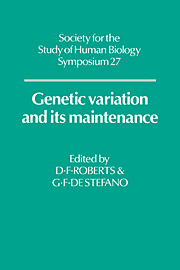Book contents
- Frontmatter
- Contents
- Preface
- Part I Genetic Diversity - Its Dimensions
- Part II Genetic Diversity - Its Origin and Maintenance
- Human genetic diversity in south-east Asia and the western Pacific
- Malaria-protective alleles in southern Africa: relict alleles of no health significance
- The genetic origin of the variability of the phenotypic expression of the Hb S gene
- Origin and maintenance of genetic variation in Black Carib populations of St. Vincent and Central America
- Historical and demographic factors and the genetic structure of an Afro-American Community of Nicaragua
- Migration and genetic polymorphisms in some Congo peoples
- Population structure studies and genetic variability in humans
- Inbreeding and the incidence of recessive disorders in the populations of Karnataka, South India
- Genetic diversity at the albumin locus
- GENETIC DIVERSITY - APPLICATIONS AND PROBLEMS OF COMPLEX CHARACTERS
- Index
Migration and genetic polymorphisms in some Congo peoples
Published online by Cambridge University Press: 05 March 2012
- Frontmatter
- Contents
- Preface
- Part I Genetic Diversity - Its Dimensions
- Part II Genetic Diversity - Its Origin and Maintenance
- Human genetic diversity in south-east Asia and the western Pacific
- Malaria-protective alleles in southern Africa: relict alleles of no health significance
- The genetic origin of the variability of the phenotypic expression of the Hb S gene
- Origin and maintenance of genetic variation in Black Carib populations of St. Vincent and Central America
- Historical and demographic factors and the genetic structure of an Afro-American Community of Nicaragua
- Migration and genetic polymorphisms in some Congo peoples
- Population structure studies and genetic variability in humans
- Inbreeding and the incidence of recessive disorders in the populations of Karnataka, South India
- Genetic diversity at the albumin locus
- GENETIC DIVERSITY - APPLICATIONS AND PROBLEMS OF COMPLEX CHARACTERS
- Index
Summary
INTRODUCTION
In ancient times, the equatorial forest and the Sahara desert were veritable geographical barriers to the migration of human populations from the Sudan to areas elsewhere in Africa. About the year 300 BC, during the Nok civilisation of the Niger-Cameroons plateau the central and southern regions of the African continent began to be colonised by the Proto-Bantu. These peoples had learned how to work iron and so were helped in this expansion by their newly developed stronger tools to clear ways through the forest and thus came to settle in the open territories to the south (Ki Zerbo, 1977; Alexandre, 1981). From this slow but irresistible flow of these early groups, all the Bantu populations settled in the African regions south of the northern hinge of the rain mantle are thought to be derived.
The present Bakongo and Bateke populations of southern Congo, the Pool region and the central plateau (Cuvette region), together with the Beti of its more northern regions, are among those whose ancestors participated in these migrations, though at different historical times. The powerful Mokoko Teke kingdom was already established in southern Congo by the fifteenth century AD and independent of the pre-existing Kongo kingdoms (Oliver & Fage, 1974; Ki Zerbo, 1977; Alexandre, 1981; Mair, 1981).
The migration to the north-west Congo was much later. It was only in the eighteenth century that Beti populations of the Mbochi ethnic group settled along the northern border of the Congo forest, forced south from the Sudan savannah lands by pressure from invaders said to be “centaures rouges au corps couvert d'ecailles” (Alexandre, 1981).
- Type
- Chapter
- Information
- Genetic Variation and its Maintenance , pp. 191 - 198Publisher: Cambridge University PressPrint publication year: 1986
- 4
- Cited by

